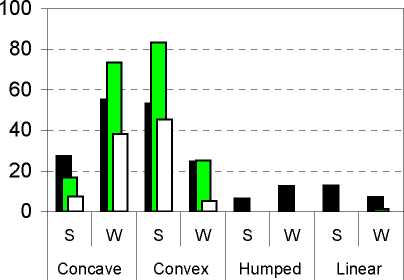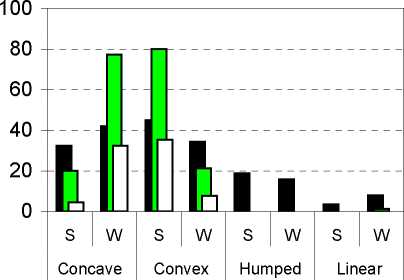compared to the RNNE or RANE predictions. Interestingly, the average shape of convex EBR
functions is almost identical to the one predicted in the RNNE for both treatments (cf. Figure
1) so that the low-balling prediction of Maskin and Riley (2000a) is empirically robust to the
behavior of Weak bidders.
Treatment LOW
Treatment MIX

■ Obs □EBR □ Matched

■ Obs □EBR □ Matched
Figure 3: Distribution of bid function shapes in LOW and MIX (S: Strong, W: Weak)
The submission of concave bid functions by Weak bidders (49%) is not supported by the
RANE (or RNNE) prediction. However, such a shape is frequently recommended as a best-
reply to the observed behavior of Strong bidders, since 75% of all EBR functions for Weak
bidders are concave. In both treatments, such matched cases with concave functions constitute
about 40% of all bid functions submitted by Weak bidders. Furthermore, while Nash
equilibrium predicts convex bid functions for Weak bidders in both treatments, the observed
and the EBR functions are convex in only about 20% to 30% of the cases. The plots in the
lower panels of Figure 4 reveal a close fit of the shape of the average concave bid functions to
22
More intriguing information
1. PER UNIT COSTS TO OWN AND OPERATE FARM MACHINERY2. THE ECONOMICS OF COMPETITION IN HEALTH INSURANCE- THE IRISH CASE STUDY.
3. Lumpy Investment, Sectoral Propagation, and Business Cycles
4. DEMAND FOR MEAT AND FISH PRODUCTS IN KOREA
5. The name is absent
6. Evaluation of the Development Potential of Russian Cities
7. Lending to Agribusinesses in Zambia
8. The name is absent
9. THE MEXICAN HOG INDUSTRY: MOVING BEYOND 2003
10. Julkinen T&K-rahoitus ja sen vaikutus yrityksiin - Analyysi metalli- ja elektroniikkateollisuudesta